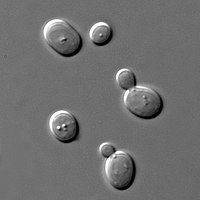
Photo from wikipedia
In last decade, nondairy herbal drinks have attracted the attention of consumers and researchers due to their beneficial effects on health resulted from their content of polyphenols (Annuzzi et al.,… Click to show full abstract
In last decade, nondairy herbal drinks have attracted the attention of consumers and researchers due to their beneficial effects on health resulted from their content of polyphenols (Annuzzi et al., 2014). Kombucha is a fermented probiotic and carbonated beverage produced by co-cultures of bacteria and osmophilic yeasts in sweeten tea (Amarasinghe et al., 2018; Yikmis & Tuggum, 2019; Gaggia et al., 2018; Zhao et al., 2018; Kozyrovska et al., 2012). Fermentation of kombucha includes production of alcohol, lactic and acetic acid (VillarrealSoto et al., 2018). in the first days of fermentation, glucose and fructose will be produced from sucrose by the microbial invertase enzyme. Then yeast convert glucose to CO2 and ethanol (Sreeramulu et al., 2000; Loncar et al., 2006). Acetobacteria play their role by converting ethanol to acetic acid. Ethanol, acetic acid, and gluconic acid are the main products kombucha tea fermentation (Velićanski et al., 2014; Vazquez-Cabral et al., 2014).
Journal Title: Food Science and Technology International
Year Published: 2021
Link to full text (if available)
Share on Social Media: Sign Up to like & get
recommendations!